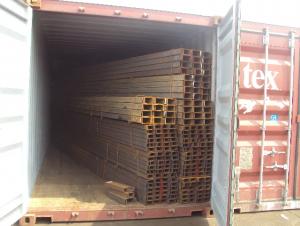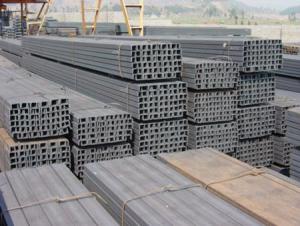Steel channel GB for sale
- Loading Port:
- Shanghai
- Payment Terms:
- TT OR LC
- Min Order Qty:
- 25 m.t.
- Supply Capability:
- 10000 m.t./month
OKorder Service Pledge
OKorder Financial Service
You Might Also Like
Steel U Channel Details:
Minimum Order Quantity: 25 Tons Unit: m.t. Loading Port: Xingang Port
Supply Ability: 1000 Tons Per Day Payment Terms: TT or L/C
Product Description:
Specifications of Steel U Channel:
Standard Applied: GB Standard, EN Standard(UPN), JIS Standard
Sizes: 50mm to 300mm
Material Grade: Q235B, Q345B, S235JR, SS400, ASTM A36
As shown in the figure:
Usage/Application of Steel U Channel:
The steel u channel can be applied to construction of warehouses, workshops, sport stadiums and car parks etc. In details, the steel u channel belongs to carbon structural steel which is applied to in the field of construction and machinery. The steel u channel is usually used for arch-itechtural structure, and they could be welded in order to support or hang a vari-ety of facilities. They are also usually used in combination with I beam. Generally,the steel u channel must possess perfect welding property, riveting property and mechanical property and so on.
Package & Delivery: Steel U Channel
The steel u channel will be packed in bundle with steel wire at each end of every bundle and color marking in order to help the customer to recognize his goods more easily at sight.
And steel u channel could be loaded into 20ft or 40ft container, or by bulk cargo. If the weight of each bundle reaches less than 3.5 mt, the loading by break bulk cargo should be choosed. When the weight of each bundle reaches less than 3mt, the loading by container should be choosed.
As for the transportaion from mill to loading port, the truck will be usually used. And the maximum quantity for each truck is 40mt.
All in all, we could do in accordance with customer's request
- Q: What are the different types of connections for steel channels in solar panel installations?
- There are several types of connections used for steel channels in solar panel installations. These connections are crucial for securing the channels in place and ensuring the stability and longevity of the solar panel system. 1. Bolted Connections: This is one of the most common types of connections used in solar panel installations. It involves using bolts, nuts, and washers to securely fasten the steel channels to the supporting structures or mounting brackets. Bolted connections provide a strong and reliable attachment, and they are easily adjustable and removable if needed. 2. Welded Connections: Welding is another popular method for connecting steel channels in solar panel installations. It involves melting the edges of the channels and fusing them together, creating a solid and permanent connection. Welded connections are durable and offer excellent structural integrity. However, they require skilled welders and specialized equipment to ensure proper execution. 3. Clamped Connections: Clamps are often used to connect steel channels in solar panel installations. These clamps are typically made of metal and are designed to securely grip the channels. Clamped connections are easy to install and adjust, making them a convenient choice. However, they may not provide the same level of strength and stability as bolted or welded connections. 4. Adhesive Connections: In some cases, adhesive bonding agents or structural adhesives may be used to connect steel channels in solar panel installations. These adhesives create a strong bond between the surfaces, ensuring a secure attachment. Adhesive connections are often used in combination with other connection methods to enhance their overall strength and stability. It is important to consult with a professional solar panel installer or engineer to determine the most suitable type of connection for a specific installation. Factors such as the load-bearing requirements, environmental conditions, and structural considerations should be taken into account to ensure the safety and efficiency of the solar panel system.
- Q: What are the different load distribution techniques for steel channels?
- There are several load distribution techniques for steel channels, including continuous distribution, point distribution, and line distribution. Continuous distribution involves spreading the load evenly across the entire length of the channel, ensuring a uniform distribution of forces. Point distribution focuses the load at specific points along the channel, often achieved by using supports or brackets. Line distribution involves applying the load along a specific line or area of the channel, which is commonly used for concentrated loads or when the load is not distributed evenly. These techniques allow for efficient load distribution and help ensure the structural integrity of the steel channels.
- Q: Are steel channels suitable for telecommunications infrastructure projects?
- Telecommunications infrastructure projects can benefit greatly from the use of steel channels. These channels possess numerous advantages that make them perfect for these types of projects. Firstly, they boast exceptional strength and durability, guaranteeing that the telecommunications infrastructure can endure harsh environmental conditions and bear the weight of the equipment. Additionally, steel channels are highly versatile and can be easily customized to meet the specific requirements of each project, including different sizes and shapes. Moreover, they exhibit excellent electrical conductivity, which is essential for efficient signal transmission in telecommunications systems. Furthermore, steel channels can be galvanized or coated to enhance their resistance to corrosion, thereby extending the lifespan of the infrastructure. Overall, steel channels provide a dependable and cost-effective solution for telecommunications infrastructure projects, making them an excellent choice for such applications.
- Q: How do steel channels perform in extreme weather conditions?
- Steel channels typically perform well in extreme weather conditions. Due to their strength and durability, they can withstand high winds, heavy rain, and even snow loads. Additionally, steel channels are resistant to corrosion, making them suitable for use in coastal areas or places with high humidity. Overall, their robustness and weather resistance make steel channels a reliable choice for various construction and infrastructure projects.
- Q: Can steel channels be welded or bolted together?
- Yes, steel channels can be welded or bolted together. Welding involves joining the channels by melting the edges and allowing them to cool and solidify, creating a strong bond. This method is commonly used for permanent connections where high strength is required. On the other hand, bolting involves using bolts and nuts to secure the channels together. This method is often used when the connection needs to be adjustable or temporary. Both welding and bolting provide reliable and sturdy connections for steel channels, but the choice between the two depends on the specific application and requirements.
- Q: What are the factors to consider when determining the appropriate length of a steel channel?
- When it comes to determining the ideal length for a steel channel, there are several factors that must be taken into consideration. These factors encompass the purpose of the channel, the structural requirements, and the limitations imposed by manufacturing and transportation processes. To begin with, the intended use of the steel channel plays a pivotal role in determining its length. The purpose for which the channel will be employed, whether it be to support beams, frame structures, or act as a conduit, will dictate the appropriate length. It is imperative to thoroughly assess the specific requirements of the project and ensure that the chosen length of the channel aligns with the overall design plan. Additionally, the structural requirements of the application must be accounted for. Elements such as load-bearing capacity, deflection limits, and the necessity for additional support or reinforcement can influence the suitable length of the steel channel. Engineering calculations and structural analysis should be carried out to ascertain the necessary dimensions and ensure that the channel is capable of withstanding the anticipated forces and stresses. Furthermore, it is important to consider the limitations imposed by manufacturing and transportation processes. Steel channels are typically produced in standard lengths, so it is crucial to select a length that minimizes material waste and cost. The logistics of transportation, such as the size of the delivery vehicle or the availability of suitable transportation methods, may also impact the maximum length that can be feasibly used for a project. Other factors that should be taken into account include the installation process, fabrication requirements, and any potential future modifications. It is vital to evaluate these aspects in order to ensure that the chosen length of the steel channel is practical, cost-effective, and aligned with the overall objectives of the project. In conclusion, determining the appropriate length of a steel channel necessitates considering the intended use, structural requirements, manufacturing and transportation limitations, installation process, fabrication requirements, and potential future modifications. By carefully assessing these factors, one can select a length that fulfills the needs of the project while guaranteeing structural integrity and efficiency.
- Q: Are steel channels available in different lengths?
- Yes, steel channels are available in different lengths.
- Q: How do steel channels contribute to thermal insulation?
- Thermal insulation is not achieved solely by steel channels. Rather, steel channels serve as structural components in construction, commonly used in the framing of walls or ceilings. However, in relation to thermal insulation, steel channels can be utilized as part of a system to enhance overall insulation performance. To incorporate steel channels into thermal insulation systems, one can construct a framework or support structure for insulating materials like foam boards or mineral wool. These materials are then placed within the steel channels, establishing a barrier that aids in reducing heat transfer. By supplying a stable and secure framework, steel channels ensure the proper installation and maintenance of insulation materials. This eliminates any gaps or air pockets that may compromise insulation effectiveness. Moreover, steel channels have the capacity to create air cavities or gaps within the insulation system. These air pockets act as additional barriers to heat transfer since air is a poor conductor of heat. By minimizing direct contact between interior and exterior surfaces, steel channels contribute to the overall thermal insulation of the structure. It is crucial to recognize that while steel channels can play a role in thermal insulation, they alone are insufficient for effective insulation. They must be used in conjunction with suitable insulating materials and other insulation techniques, such as gap sealing and the use of reflective surfaces, to achieve optimal thermal insulation performance.
- Q: How are steel channels transported and stored?
- Steel channels are typically transported using trucks or trains, with careful consideration given to weight distribution and secure packaging. Once at the storage facility, they are usually stored in racks or on shelves, taking into account their size and weight to ensure safe and efficient stacking.
- Q: What are the different types of accessories used with steel channels in construction?
- There are several different types of accessories used with steel channels in construction, including brackets, connectors, clamps, and fasteners. These accessories are used to secure the steel channels in place, connect them to other structural components, provide additional support, and enhance their overall functionality.
Send your message to us
Steel channel GB for sale
- Loading Port:
- Shanghai
- Payment Terms:
- TT OR LC
- Min Order Qty:
- 25 m.t.
- Supply Capability:
- 10000 m.t./month
OKorder Service Pledge
OKorder Financial Service
Similar products
Hot products
Hot Searches
Related keywords




























